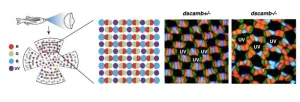Life has evolved over billions of years, adapting to the changing environment. Similarly, enzymes—proteins that speed up biochemical reactions (catalysis) in cells—have adapted to the habitats of their host organisms. Each enzyme has an optimal temperature range where its functionality is at its peak. For humans, this is around normal body temperature (37 °C). Deviating from this range causes enzyme activity to slow down and eventually stop. However, some organisms, like bacteria, thrive in extreme environments, such as hot springs or freezing polar waters. These extremophiles have enzymes adapted to function in harsh conditions.
For instance, enzymes from thermophiles, organisms that thrive in high-temperature environments, are heat resistant and show good catalytic activity at high temperatures; declining significantly at lower temperatures. In contrast, enzymes from mesophiles and psychrophiles, organisms that inhabit moderate and cold environments, lack thermostability and show high catalytic activity at lower temperatures.
Evidence suggests that the earliest life forms were thermophiles, which gradually adapted to lower temperatures as Earth cooled. An enzyme’s ability to remain catalytically active at lower temperatures is linked to the flexibility of its molecular structure. However, the precise molecular mechanisms behind this adaptation remain unclear. Understanding how enzymes from thermophilic organisms evolved to function at lower temperatures could not only provide insights into evolutionary biology but also aid in bioengineering enzymes optimized for different temperature conditions.
Since ancestral enzymes no longer exist, scientists use a technique called ancestral sequence reconstruction (ASR) to study their evolution. ASR combines molecular phylogenetics with genetic and protein engineering to infer and reconstruct the genetic or protein sequences of extinct organisms using phylogenetically related sequences from living species. 3-Isopropylmalate dehydrogenase (IPMDH), an enzyme involved in leucine biosynthesis (the metabolic pathway that synthesizes leucine, one of the 20 proteinogenic amino acids), is an excellent candidate for studying thermostability and cold adaptation due to its extensive evolutionary history.
To that end, a research team led by Professor Satoshi Akanuma from Waseda University, Japan, in collaboration with Assistant Professor Sota Yagi from Waseda University, Dr. Subrata Dasgupta, and Dr. Shunsuke Tagami from the RIKEN Center for Biosystems Dynamics Research, investigated the evolutionary improvement of IPMDH activity at low temperatures. They traced its evolution from the enzyme of the most ancient thermophilic common ancestor to the mesophilic bacterium Escherichia coli using ASR. Their study was published online in the journal Protein Science on February 19, 2025.
“We reconstructed 11 intermediate ancestral enzymes along the evolutionary trajectory connecting the last common bacterial ancestor and E. coli IPMDH (EcIPMDH),” explains Akanuma. “After that, we analyzed changes in enzyme activity at each evolutionary stage, especially improvements in catalytic activity at low temperatures.”
They observed a notable increase in catalytic activity at 25 °C, which did not follow a gradual, linear pattern. Instead, a dramatic improvement occurred between the fifth (Anc05) and sixth (Anc06) intermediate ancestors.
What caused this sudden boost in enzymatic efficiency?
To find the underlying molecular mechanisms, the researchers compared the amino acid sequences of the ancestral enzymes and used site-directed mutagenesis, a technique that allows precise alterations to DNA and protein sequences. They identified three key amino acid substitutions that significantly enhanced catalytic activity at 25 °C. Surprisingly, these mutations occurred far from the active site, challenging the previous belief that temperature adaptation is primarily driven by active-site modifications.
Molecular dynamics simulations revealed a key structural shift between Anc05 and Anc06. While Anc05 remained in an open conformation, Anc06 could adopt a partially closed conformation, reducing activation energy and enhancing enzymatic efficiency at low temperatures.
This transition occurred 2.5–2.1 billion years ago, coinciding with the Great Oxidation Event, which led to a sharp decline in atmospheric methane and global cooling. The researchers suggest that this climate shift may have driven the adaptation of enzymes to lower temperatures.
By identifying key mutations that enhance enzyme efficiency, ASR provides valuable insights into how life evolved in response to Earth's changing environment. “Applying this approach to various enzymes is expected to reveal how organisms and their enzymes have evolved in response to Earth's environmental changes over the past four billion years,” Akanuma concluded.
Beyond fundamental research, these findings could aid in bioengineering enzymes for applications in biotechnology, pharmaceuticals, and environmental science.
***
Reference
Authors: Shuang Cui1, Subrata Dasgupta2, Sota Yagi1,2, Madoka Kimura1, Ryutaro Furukawa1, Shunsuke Tagami2, and Satoshi Akanuma
DOI: 10.1002/pro.70071
Affiliations: 1Faculty of Human Sciences, Waseda University, Tokorozawa, Japan
2RIKEN Center for Biosystems Dynamics Research, Yokohama, Japan
About Waseda University
Located in the heart of Tokyo, Waseda University is a leading private research university that has long been dedicated to academic excellence, innovative research, and civic engagement at both the local and global levels since 1882. The University has produced many changemakers in its history, including nine prime ministers and many leaders in business, science and technology, literature, sports, and film. Waseda has strong collaborations with overseas research institutions and is committed to advancing cutting-edge research and developing leaders who can contribute to the resolution of complex, global social issues. The University has set a target of achieving a zero-carbon campus by 2032, which is in line with the Sustainable Development Goals (SDGs) adopted by the United Nations in 2015.
To learn more about Waseda University, visit https://www.waseda.jp/top/en.
About Professor Satoshi Akanuma
Dr. Satoshi Akanuma is a Professor at the Faculty of Human Sciences, Waseda University, Japan. He completed his PhD in 1998, graduating from the Tokyo Institute of Technology. Since then, he has been associated as a researcher with many prestigious institutes, such as the University of Cologne, RIKEN, JST BIRD, NFRI, and the Tokyo University of Pharmacy and Life Sciences. Dr. Akanuma joined Waseda University in 2015 and has been a faculty member for 10 years. His research is focused on the design of thermally stable and low-temperature active enzymes, the development of plastic-degrading enzymes, the experimental resurrection of ancestral proteins, and exploring amino acid compositions in primordial proteins.
END




